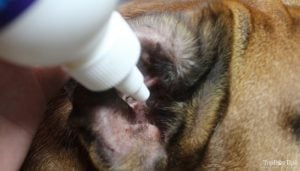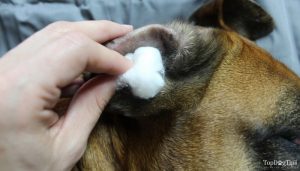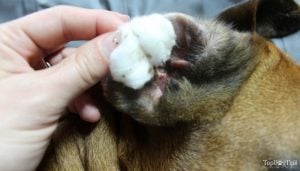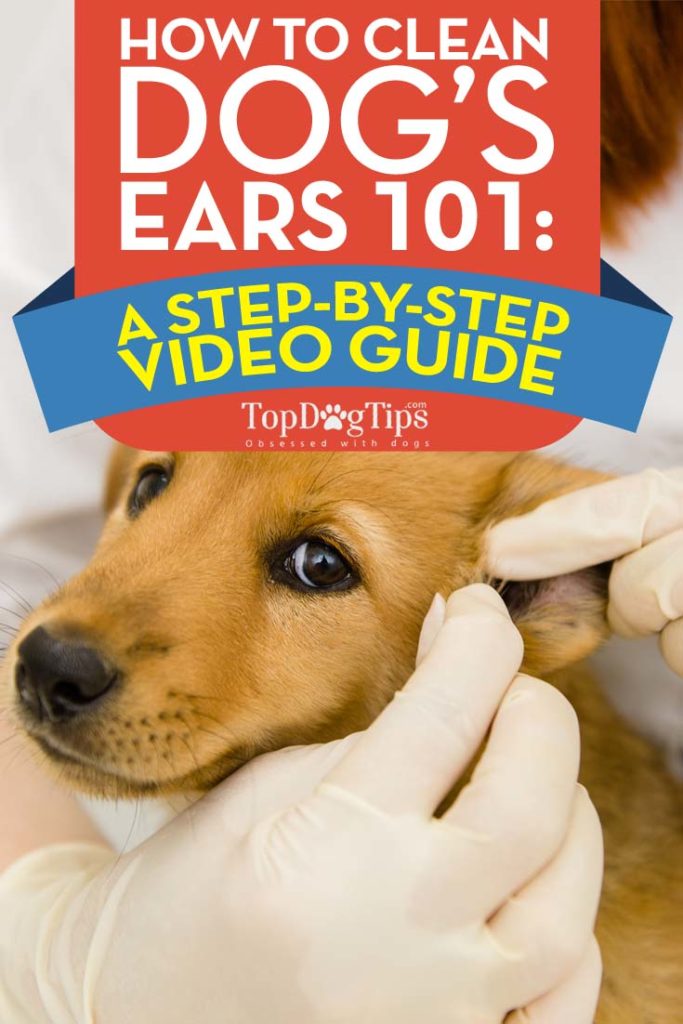Table of Contents
Some dog owners forget to clean their dogs' ears, but ear care is extremely important and cannot be overlooked. Learning how to clean dog ears will prevent health issues, help you deal with many ear problems and ear infections, and save you money on vet bills.
Dog Ear Cleaning 101
There are several reasons why I regularly check and clean my four dogs' ears. Cleaning a dog's ears at home gives you an opportunity for a regular inspection to detect infections, ear wax overload, ear mites, and other possible issues. If you notice any problems during these routine inspections, you'll have a better chance to avoid serious complications.
Canine ear disease is the third most common health problem in veterinary hospitals. This is because, unbeknownst to many pet owners, dogs actually have sensitive ears that are prone to a variety of health issues. Early detection and prompt treatment can reduce the risk of hearing loss and will relieve discomfort for the dog.
It takes about 30 seconds to check your dog's ears; to clean dog ears, it takes only a few minutes. I can usually clean one of my dog's ears in less than 10 minutes. Even if you have multiple dogs, this will take a small amount of time each month, and will aid in your pet's overall health and well-being. You will get better and more proficient with time.
How to Clean Dog Ears at Home
1. Preparation
The first step in learning how to clean dog ears is to prepare the dog's ear area. Make sure it's completely dry and that any matted or tangled hair around your dog's ear is properly cared for. You don't want to cause your dog any discomfort while cleaning ears or your pet won't be very receptive to it next time.
If there is excessive hair in a dog's ear canal, it will need to be removed. However, this should only be done by a professional. As I explain in my video above, a dog's ear canal is a very delicate area and even the smallest amount of irritation could cause extensive damage. Fortunately, trimming dog's ear hair is rarely needed.
2. Inspect the Dog's Ear
Once the grooming is finished and you've prepared the area, it's time for an initial dog ear inspection. This is a very quick process, but also the most important step before you get to clean dog ears.
Start by feeling your pet's ear flap and the area around the ear with your bare hands. You should be looking for lumps, lesions, swelling, redness, discharge of any kind, or anything else that doesn't look right.
If you notice anything out of the ordinary, you need to call your veterinarian immediately. I explain the importance of this in my video, as many dog owners think that a thorough ear cleaning in dogs will benefit health problems. However, cleaning a dog's ear when there is already an issue could make the problem worse.
If you don't spot anything out of the ordinary, you can start your dog's ear-cleaning process. In the next step, I'll explain in full detail how to clean dog ears in an easy and safe way and what to use for this.
3. How to Clean Dog Ears the Right Way
After you confirm that your pup's ears look healthy, move on to the cleaning process.
You'll need to buy a quality dog ear cleaner that is specifically made for dogs only. You will also need cotton balls. I cannot stress enough how important it is that you NEVER use cotton swabs (like Q-tips) to clean your dog's ear.
Note: The reason why Q-tips are not good for cleaning dog ears is that it's very easy to push cotton swabs too deeply into a dog's ear. Unlike cleaning your own ears, you won't feel when you push it too far, and you'll cause damage. You don't actually want to get into your dog's inner ear. This could result in permanent damage to the ear and his hearing.
Once you have a dog ear cleaner and cotton balls at the ready, you can start the process.
1. Fill the ear with a cleaning solution
To begin, tip your dog onto his side. You'll see my boxer Chloe in the above video lying on her side. Pour a small amount of dog ear-cleaning solution (just enough to fill the ear canal) right into your pet's ear. Your dog will immediately want to shake his head, so be sure to brace for it.
2. Massage the ear
Close the ear and begin rubbing the base of the ear in a circular motion, gently and slowly. This will help the solution to break up any wax build up. Massage the base of the ear for about 30 seconds. After you've finished, let your dog sit up and shake his head. Don't worry, this is a natural instinct that your dog will do without hesitation.
3. Wipe the inside clean
After your dog shakes his head, it will break up a lot of the wax and bring it out of the canal. Open the ear and then gently wipe the inside clean with a cotton ball. In here, you don't need to wipe the ear completely clean. Just gently wipe it until you've gotten the bulk of the debris and wax out.
4. Do not dry the ear
The process stops here. A dog's ears are designed to dry themselves, so you don't need to worry about getting every drop of solution.
Note: While this technique of cleaning dog ears is important, picking out an effective dog ear-cleaning solution is just as essential. However, do NOT confuse canine ear cleaners with dog ear infection treatments (used for a specific health problem). These products contain different ingredients and cannot be used interchangeably.
4. How Often to Clean Dog Ears
When talking about how to clean dog ears, the most common question that I always hear is, how often should I clean dog ears? The answer depends on many factors. It can be anywhere from once or twice a week to every two months.
Your dog's breed, age, activity level, coat type, and level of earwax production will all determine how often his ears will need to be cleaned. Generally, at least inspecting your dog's ears should be done every other day to make sure there's nothing abnormal.
A brief conversation with your vet will help you find the right answer. On average, most dogs should have their ears cleaned at least once per month, but your dog may need it more frequently or less frequently. If your dog is a regular swimmer, it could be as often as once a week. Talk to your veterinarian to decide on the best schedule for your Fido.
READ NEXT: A Case Against Cutting Dogs’ Tails and Ears
Want to share this?

















